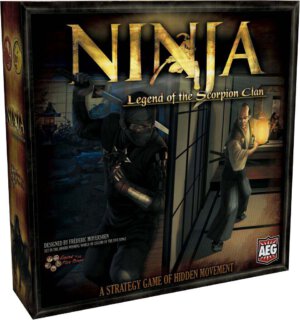
Publisher: AEG
Designer: Fréderic Moyersoen
Artists: Conceptopolis, Llyn Hunter, Yutthapong Kaewsuk, MuYoung Kim, Jorge Matar, and Florian Stitz
Year: 2011
Players: 2-4
Ages: 12+
Playing Time: 45 Minutes
Genre: Multiplayer player hidden movement stealth game
Retail Price: TBD
Ninja is the new board game from AEG set in their Legends of the Five Rings universe. It is a hidden movement game set inside a feudal Japan era compound. The intruder player(s) are attempting to infiltrate the compound in order to complete a specific mission. The other player(s) are the guards attempting to stop the intruders. The game ends when there are no intruders left on the board (dead or escaped), or after the 20th turn. The intruders win if they complete their mission and escape. If only one escapes it is a draw, and any other outcome is a victory for the guards.
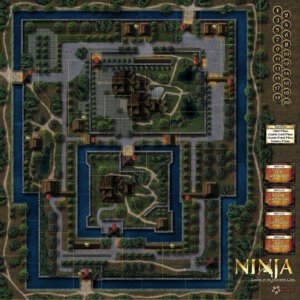
The game handles differing numbers of players well, without increasing game time. With two players, one plays the intruders and the other plays the guards. With three, one plays the Ninja intruder and the second plays the Traitor, while the third plays the guards. Finally with four players you split the guards between the last two players. The guard minis come in two separate colors for this purpose.
Setup takes a bit of effort. The guard player must place all of the guards in patrols or single sentry locations, then mark his map with the locations (their choice) of each mission objective (labeled A-F), two traps, two hidden sentries, and eight sleeping guards. The intruder player will find these as they explore the map attempting to complete their mission. They select a random mission objective from the boards provided. Mission A, for example, is to assassinate the Daimyo. Mission F is to plant incriminating evidence, and the rest are along these lines. The guard player marks all of these objectives on his map in random locations within the two houses, but of course the intruders are each looking for just one specific goal. The intruder players also mark their starting locations on their maps, and adds both ends of a secret passage that they can put from any one location to another on the map. The guard players can use it too, but they have to discover it first.
All players then build a hand of cards from the ones available. If there is a single guard player, they will start with a hand of 24 cards, leaving them many options on each turn. Plus, these cards can be redrawn after use when 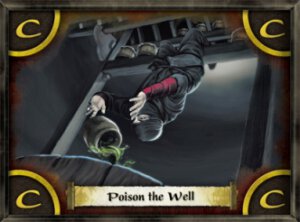
Each turn has four phases. The board has a track to watch the turn number for you, as well as another track to measure the alert level of the guards. In the beginning the alert level is low. The only real difference that the alert level makes is that the guard player gets to draw more cards as the level goes up. At low level, the guards draw no cards on their turn. This is the first phase, where the guards draw cards based on the alert level, and then the alert level drops by one level. The guards can play any or all of these drawn cards right away or add them to their hand.
The second phase is the guard card phase, where the guard player can play up to two cards from their hand. Most of these cards involve listening or searching for the intruders. The guards have stationary positions, called sentries and moving patrols of two guards which follow a patrol track on the board. The only way for either to move from their positions is by hearing an intruder or by finding one using a search card. Basically, the guard player would play a listen card. The intruder players would have to reveal if the guard heard something based on their movement. If an intruder ran, a nearby guard could hear them from up to three spaces away while if the intruder was sneaking they could only hear them from one space away.
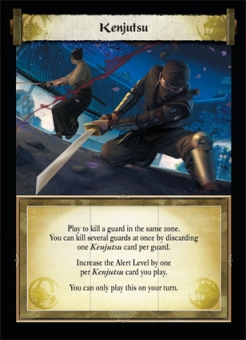
The third phase is the guard patrol phase. Each patrol moves two spaces along the patrol track. The intruders must reveal if one of the patrols cross their path.
Finally, the final phase is the intruder phase. The intruders mark their movement on their maps. They can move up to three spaces. One space is sneaking, two is walking and three is running. They can search up to two of the spaces they pass through. They ask the guard player if anything is located in each space, and the guard player must reveal if there is anything marked on their maps in those spaces. In this way the intruders discover objectives, traps, and hidden sentries. Traps raise the alert level, and hidden sentries can attack. If they discover a hidden objective and it matches the one they draw at the beginning of the game, then their mission is complete and they can now try to escape the map. If it isn’t their goal, then they have to keep searching. The intruder players can tell each other the objectives they find if they wish, and really why wouldn’t they?
The intruders can also play cards. Many of these are cards used to kill guards that have discovered them, or are in their way. One card can kill a single guard. The Traitor player also has the “It was a Cat” card, that allows them to not reveal their location if the guard player manages to hear them. Once the cards are used, they are gone for the game, so use them sparingly.
The secret passage helps the intruders a lot, as they can’t be heard while in the secret passage, and it can take them directly in from the interior of one of the houses to the edge of the board near the wall. The intruders do need to use a rope card in order to scale one of the walls, but the ropes stay in place and can be reused on their way back out.
Play continues with alternating searching, listening, and moving until the intruder complete their objective and escape, or the guards catch them and kill them. The Traitor can take two wounds and the Ninja can take three before they are killed. Additionally, the intruders can respawn if they are killed within the first ten turns. The guards can wound an intruder if they find themselves in the same space and the player has an attack card handy.
I’m not a big fan of hidden movement games, but this one seems nicely thematic and one of the better ones that I have played. I like the fact that there are hidden objectives, so that the intruders have to search to complete their missions. So it makes sense that all players have hidden maps.
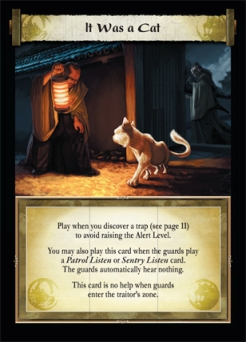
On the other hand, I prefer most of my action to take place on the board. The intruders have to keep looking between the board and their maps to see if they happen to cross the path of a guard. You have to trust that they are keeping careful watch, as you can have up to twenty guards on the board at once. So the guard player might get suspicious if the intruders are constantly able to evade them. Additionally, the intruders can get lucky and one of them can finish their objective quickly and escape. Then they can have to sit and watch to see if the other intruder player can finish their goal and escape too before they know if they won. The games take less than an hour, so this isn’t a major issue, but it can get boring for that particular player.
For this reason the game hits its sweet spot with two players. It would be better for the intruders to have separate ways to win, or if they had to assist the other player with their objective before they could escape. It also seems more entertaining to be the intruders than the guards. Once you find an intruder, they finally appear on the board with their figures. That is, until they kill of the guard that spotted them or run away, at which point they disappear and you have to start searching all over again. The intruders get to sneak around and do Ninja stuff, which is cool.
Possibly, the addition of a super guard who has their own special abilities, and can move independently, and can kill an intruder with one strike would make it more entertaining for the guards. They could lower the number of guards on the board to balance it back out.
One final thought, I think it would have been excellent if the privacy screen graphics had been made to resemble Japanese paper privacy screens rather than the player symbols they came with. I think it would have added to the thematics of the game.
Overall, an ok game with excellent components and a great theme.
- A Dungeon Delve for Kids?: A Review of Dungeon! - Oct 24, 2022
- Better, Stronger, Faster | Descent: Journeys in the Dark Second Edition Reviewed - Oct 23, 2022
- Your Planet is Doomed!: Invasion from Outer Space Reviewed - Oct 22, 2022



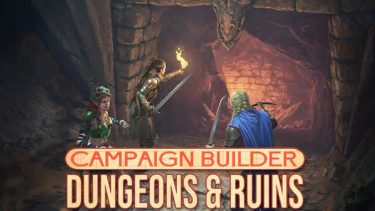

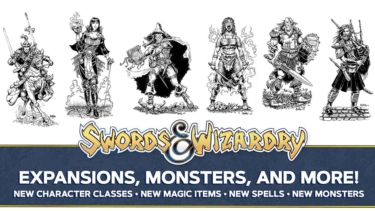
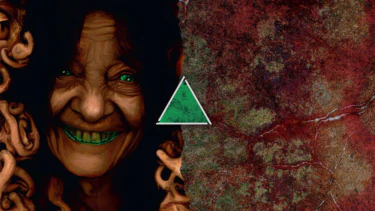



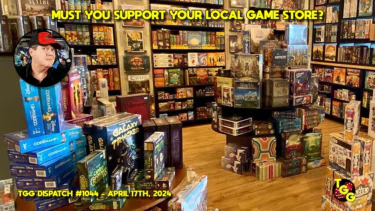
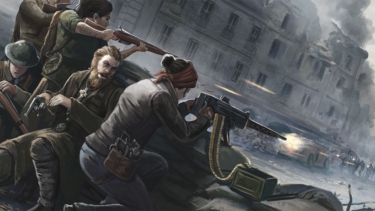

1 Comment
I have to say, from our discussion on Monday’s show, I believe I liked Ninja a little bit more than Elliott. In reality, I think it’s more the fact that we aren’t huge hidden movement games fans overall than anything else and I’m sure the game will appeal to folks who really like Nuns on the Run but would enjoy a more serious and in depth experience. With a very cool theme added in of course!